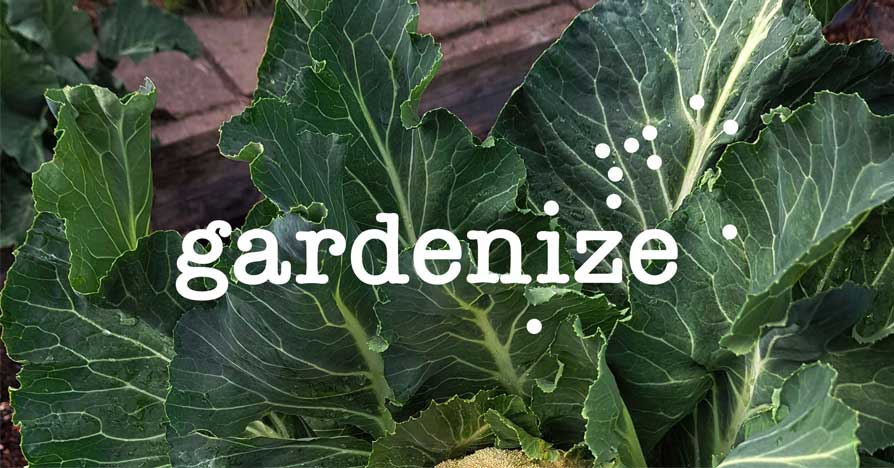DISCOVERING DAHLIAS
Discover the beauty and variety of the amazing Dahlias. Here are advice on growing them from cuttings, seed and tubers.
There are very few flowers that display such variety as the dahlias, there are thousands of cultivated forms worldwide which have been created from a genus of just two, possibly three, original species. But, in spite of their popularity, not everybody likes dahlias. What is it about them that makes people either love them or loathe them?
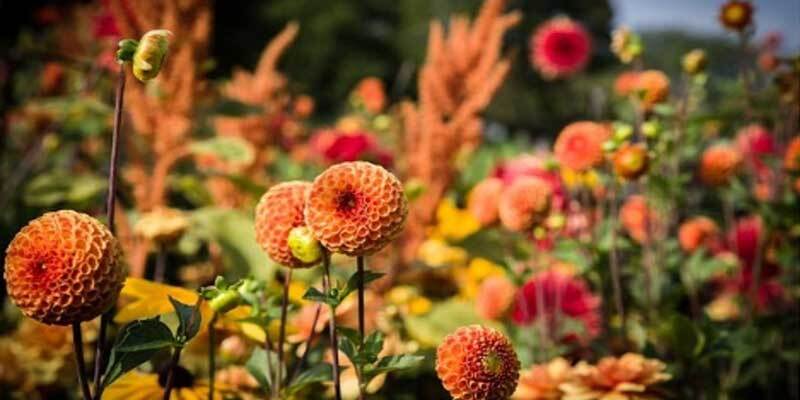
THE ORIGINS OF THE DAHLIA
The dahlia has its origins in the mountains of Mexico and Central America. It was first described and illustrated by Francisco Hernandez, botanist to Philip II of Spain, when he visited Mexico in the 16th Century. Dahlias had been cultivated as an important food source and for their medicinal properties in Mexico for centuries by the Aztecs, and the long canes of the dahlia imperialis (the tree dahlia) were used to carry water. One of the names that they gave to the dahlia was “Cocoxochitl” which means “water pipe plant”.
INTRODUCTION OF THE DAHLIA IN EUROPE
It was not until 1789, that Abbe Antonio José Cavanilles, Director of Madrid’s Royal Gardens, raised dahlia plants in Europe for the first time. Using material sent to him from Mexico, Cavanilles cultivated Dahlia pinnata and Dahlia rosea. He named the plants “dahlias” after the Swedish botanist and student of Linnaeus, Anders Dahl. However, in Germany the species was named “Georgina” after the botanist Johann Wilhelm Georgi, and this name stuck until the middle of the 19th Century. In many Eastern parts of Europe the dahlia is still referred to as the “Georgina”.

Château de Malmaison
It was the Empress Joséphine, wife of Napoléon I, who was responsible for introducing the dahlia to France in the gardens of her château, Malmaison. She was an avid plant collector, and it is said that, when some of her dahlia cultivars were stolen by a lady-in-waiting, she uprooted all the remaining ones – presumably to prevent any further thefts! In France the dahlia grew in popularity during the 19th century and became the favoured flowers of painters such as Gustave Caillebotte and Claude Monet, who grew them in their gardens and painted them. Many new varieties of dahlia were developed.
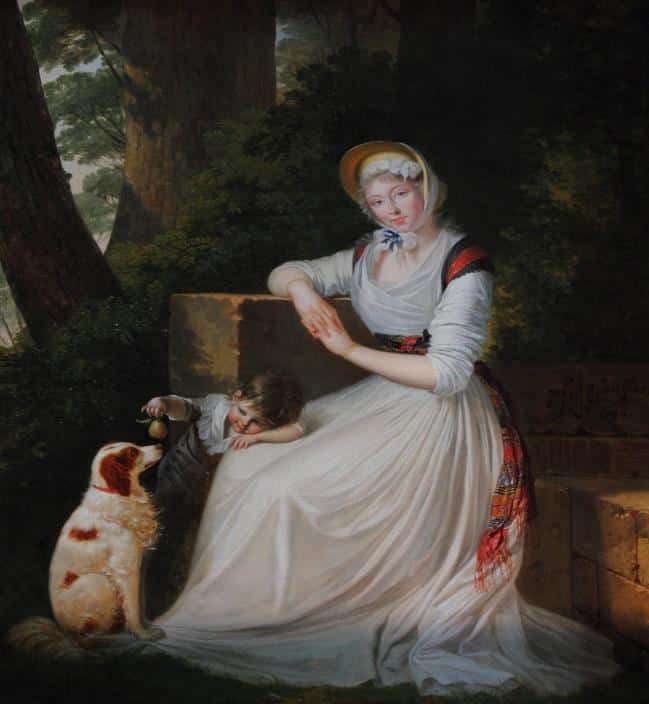
Louis Gauffier: Portrait d’Elizabeth Holland avec son fils
In England it was Lady Holland, wife of the politician Henry Richard Vassall-Fox, Lord Holland, who helped to introduce the dahlia to England. While in Spain, she sent either tubers or seeds to her London home, Holland House, where they grew and flourished. Her husband wrote the following poem about her:
“The Dahlias you brought to our isle
Your praises for ever shall speak:
Mid gardens as sweet as your smile,
And colour as bright as your cheek.”
POPULARITY OF THE DAHLIA
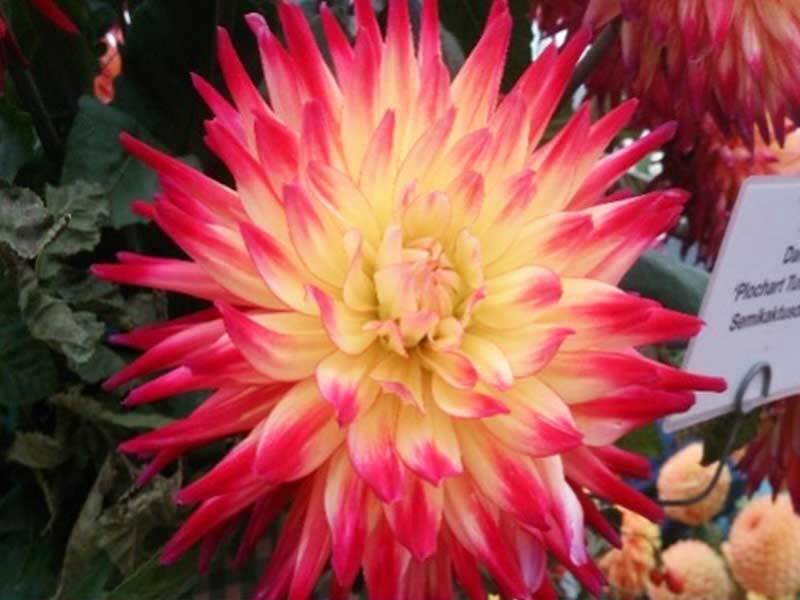
The popularity of the dahlia grew, and horticulturalists soon discovered that dahlias hybridised easily when grown from seed, making it possible to change their colours, sizes and shapes. The first double dahlias were bred in Germany in 1808, and by 1820 about 100 dahlia varieties had been cultivated. Twenty years later that number had risen to 2,000. The National Dahlia Society was formed in 1881 to “promote the dahlia by means of exhibitions (shows), trials and conferences” and dahlia societies grew up all over the country. In 1882 J.C. Loudon, the Scottish botanist, garden designer and author, wrote in his “Encyclopaedia of Gardening” that “[dahlias) were the most fashionable flower in the country”.
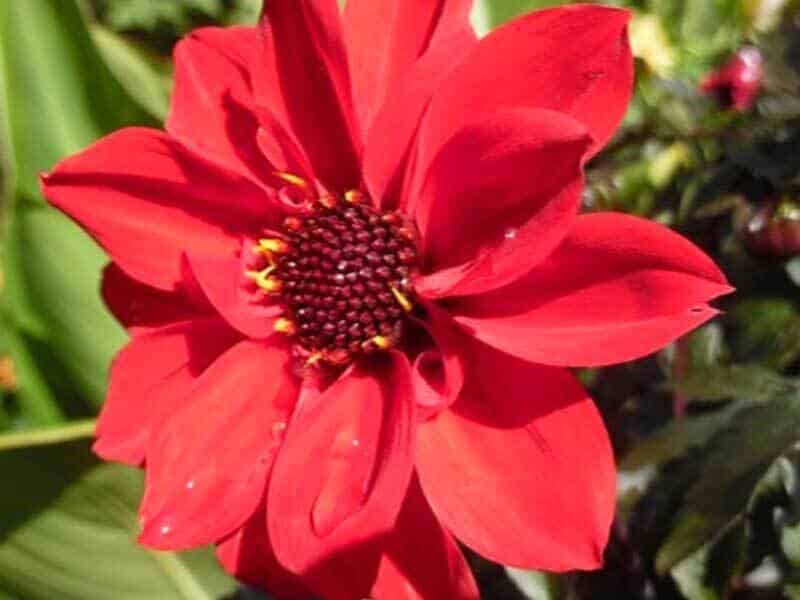
Dahlia “Bishop of Llandaff”
For a while, during the late 20th Century, dahlias fell from favour as many gardeners considered them to be too gaudy and too vulgar to be able to fit them into their borders. As Alan Titchmarsh said in an article in “Country Life” (November 2020) “Dahlias belonged on allotments and in kitchen gardens with chrysanthemums — something to be grown for exhibiting in flower shows”.
According to the blogger, Dan Cooper of thefrustratedgardner.com, it was the single-flowered variety “Bishop of Llandaff” that restored the dahlia’s popularity. “The simple red flowers with their bright yellow centres, rising above finely-cut bronze foliage, appealed to the staunchest dahlia snobs…(who used it) more as a perennial than a showstopper”.
DAHLIA VARIETIES
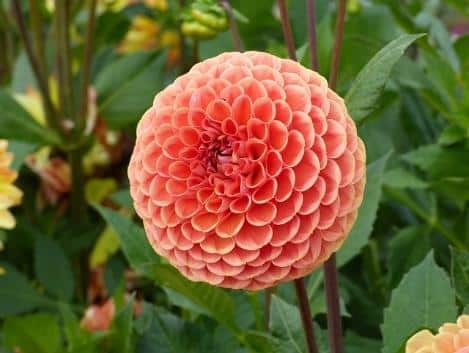
Pompom Dahlia
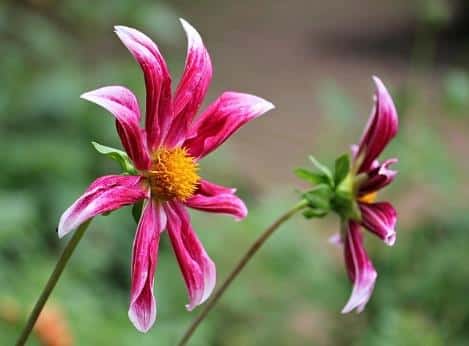
Star Dahlia
Today the dahlia is as popular as ever and there are over 50,000 different varieties which have been hybridised by growers around the world. This makes it difficult to classify them, but the UK’s National Dahlia Society lists fourteen groups of dahlias: dwarf dahlias, anemone flowered dahlias, collarette dahlias, waterlily dahlias, formal decorative, ball, pompom, cactus, semi-cactus, miscellaneous, fimbriated, star, double orchid blooms and paeony.
Dahlias are members of the Compositae family and come in a huge variety of colours. There are some that are bi-coloured or variegated. However, there is no true blue dahlia yet, in spite of the 1946 film of that name!
CULTIVATING DAHLIAS
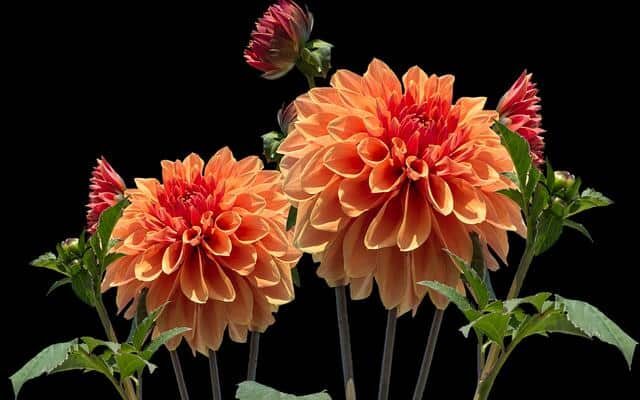
Although they originated in Central and South America, dahlias grow well in the UK provided they are not affected by frost.
Dahlias can be grown from seed, tubers or from rooted cuttings.
Growing dahlias from seed
If you’re growing dahlias from seed, you’ll need to start them off in late Winter/early Spring in the greenhouse or propagator. These will produce dahlias that can be planted out in May to flower later in the year. With this method you are more likely to get a mix of dahlias, whereas, if you want a specific variety, it is better to plant dahlia tubers.
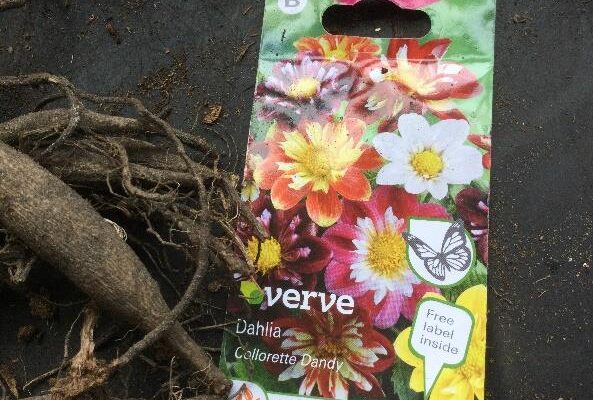
Growing dahlias from tubers
The quickest and most reliable way of growing dahlias is from tubers. These are usually available in garden centres and from mail order companies in early February.
In the Spring, place your tubers in a large, shallow try and cover lightly with compost for potting up later or pot each tuber up individually so that they start into growth early.
To position the tubers the right way up, look for the old stem or a new shoot: this is the right way up. Place the top so that it sits just below the soil surface and water well.
Remember to label them at this stage, as it’s easy to forget which variety is which otherwise!
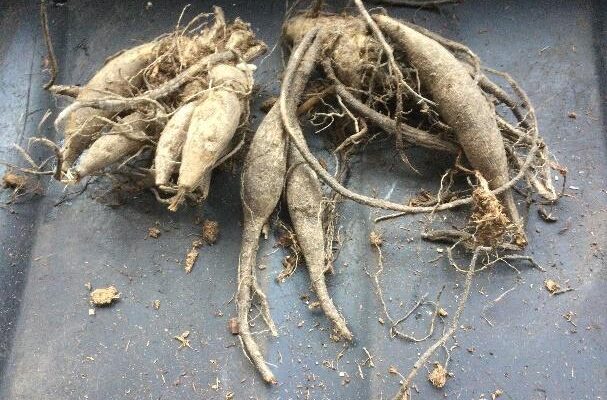
Growing dahlias from basal cuttings
Once your dahlia tubers have started to produce shoots, some of these can be removed and replanted as basal cuttings. This is a good way to increase your stock, particularly of varieties that you’re particularly fond of.
In all cases, plant your dahlias outside once the risk of frost has passed, having hardened them off for a couple of weeks beforehand. Dahlias love full sun, so choose the planting position carefully.
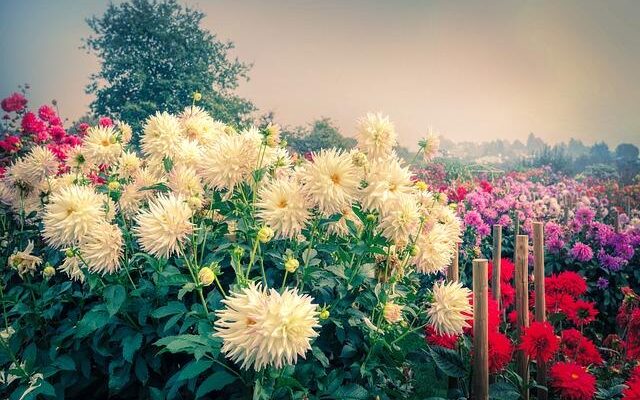
Growing on
Tall varieties will require staking and the growing tips should be pinched out to encourage the plants to branch out and produce more flowers. Dahlias need plenty of fertiliser to keep them growing, but, if you intend to store your dahlia tubers over winter, stop feeding them in September. Deadhead frequently and water from below. Dahlias need a lot of water.
Storing tubers
In a mild winter some dahlias that are left in the ground will grow again the following year. However, it’s much safer to lift them, dry them and store them during the winter. They can be packed in a box or pot and covered with dry compost or vermiculite or even wrapped in newspaper and kept in a frost-free place, such as a shed or garage, over winter. Once again, remember to label them, or you will have forgotten what they are by the following Spring!
There is some advice on growing dahlias as cut flowers in the Gardenize article “Tips for Growing Cut Flowers”, including some recommendations of suitable varieties to grow for this purpose.
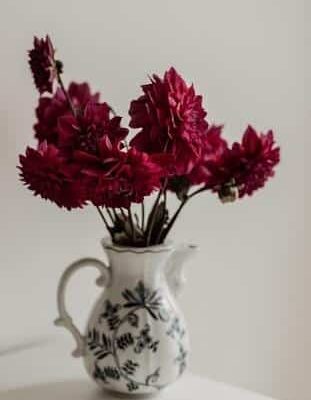
Finally, is it day-lia or dahl-ia?
As it was named after the Swedish botanist Anders Dahl, you would expect the name, logically, to be pronounced “Dahlia”, as in the name of the writer Roald Dahl. According to Jenny Uglow in her book “A Little History of British Gardening”, in 1836 the horticultural magazine “The Floricultural Cabinet” carried a whole correspondence on its pronunciation, with a certain F.R. Horner complaining that it should be “ah”: “nothing but ignorant conceit could have inflicted upon it the pronunciation as if written Daylia – it is at best a piece of affected Cockneyism”
Unfortunately affected Cockneyism seems to have prevailed, because most people in the UK call it a “Day-lia”! What’s in a name?!
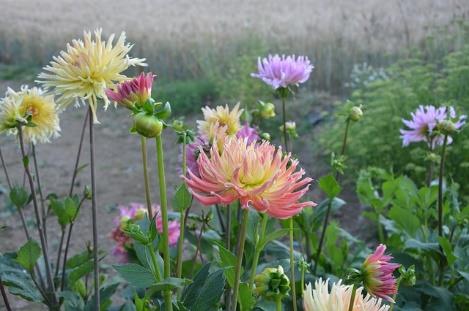

ABOUT THE AUTHOR
Caroline Bowman has been hooked on gardening ever since she grew some thyme from seed and planted it in a window box when she lived in a flat in London. Fifty years later she is still hooked on gardening, but now she lives in Lincolnshire in England where they have quite a big suburban garden as well as an allotment, where they grow fruit and vegetables. Caroline loves flowering plants, in particular, herbaceous perennials and she likes finding out about the more unusual varieties that will do well in the English climate and soil.
GARDENIZE GARDEN APP
A gardening friend with a green thumb and photographic memory
Gardenize is an app for gardening and cultivation that helps you to overview, understand and develop your garden and your gardening skills. Order makes it easier to succeed and Gardenize structures information and photos and makes it searchable for you. You also get tips and inspiration from other Gardenizers around the world. Gardenize is free to use and you can download Gardenize from the App Store or Google Play, or create an account for the Gardenize web app for web browsers.
Get to know Gardenize better here.

